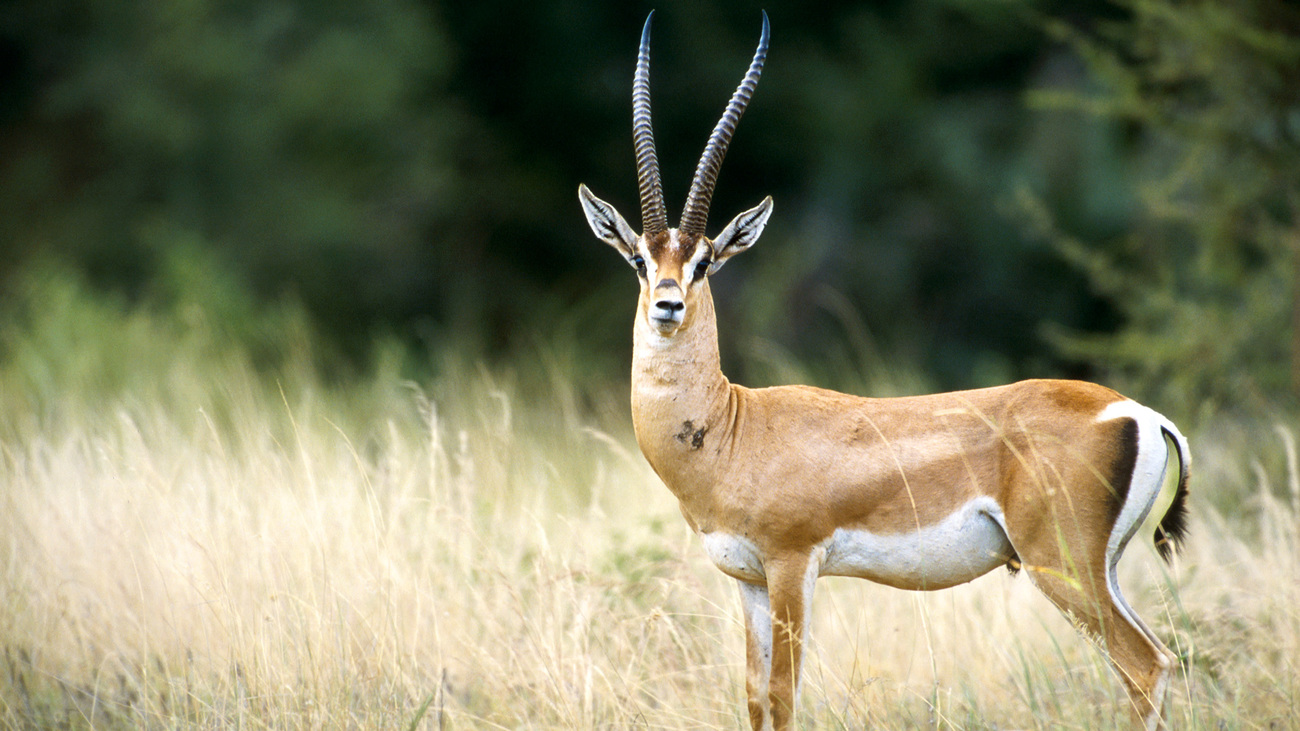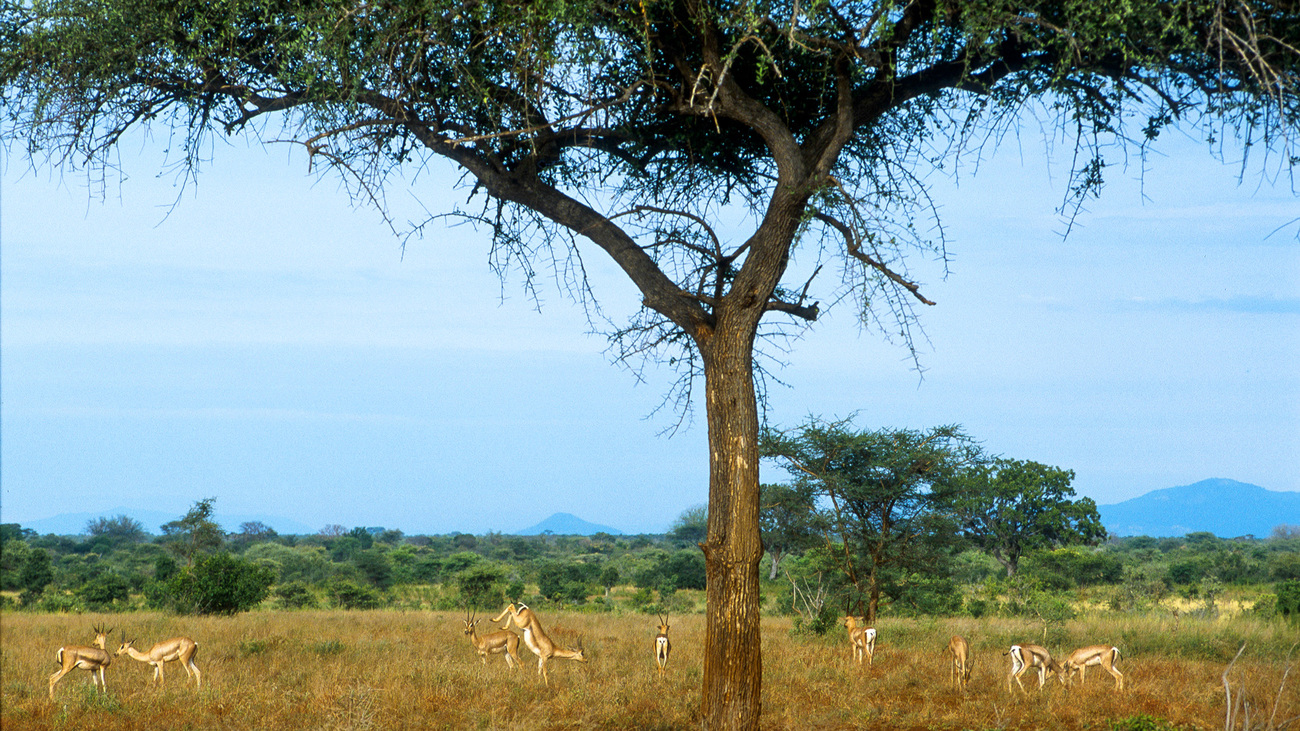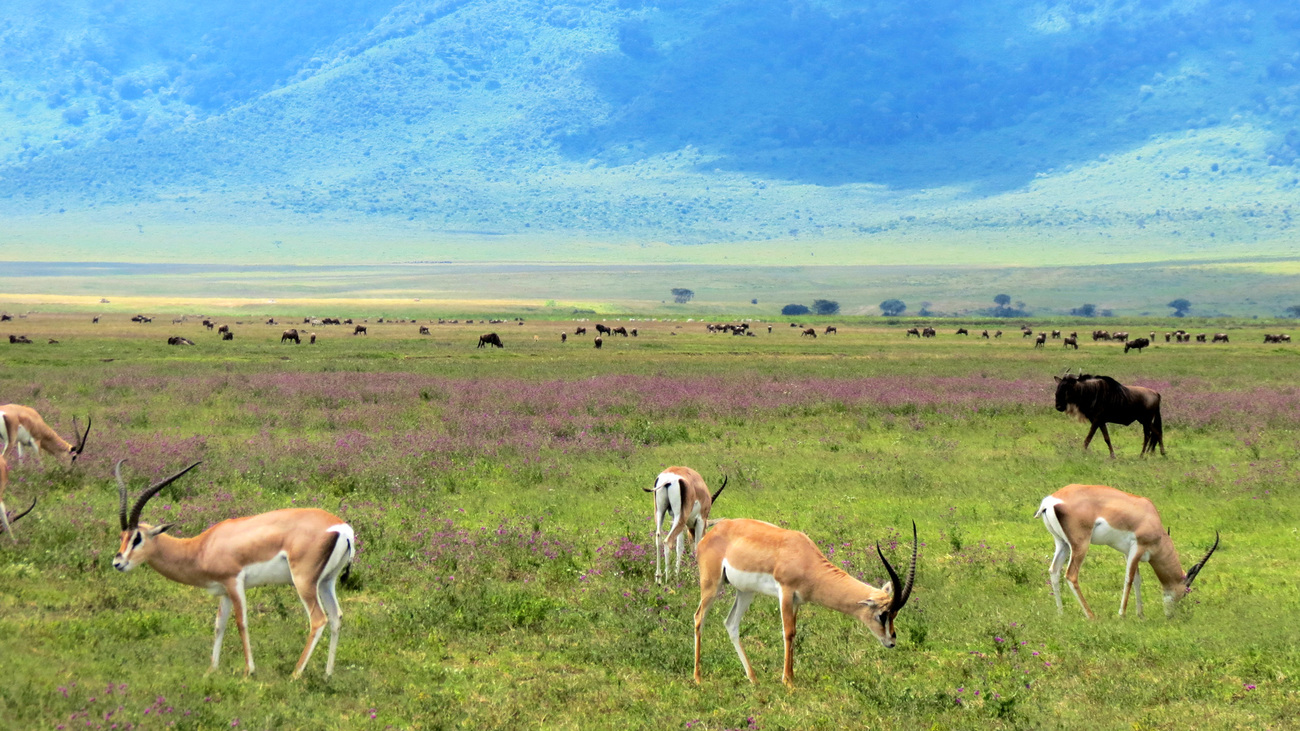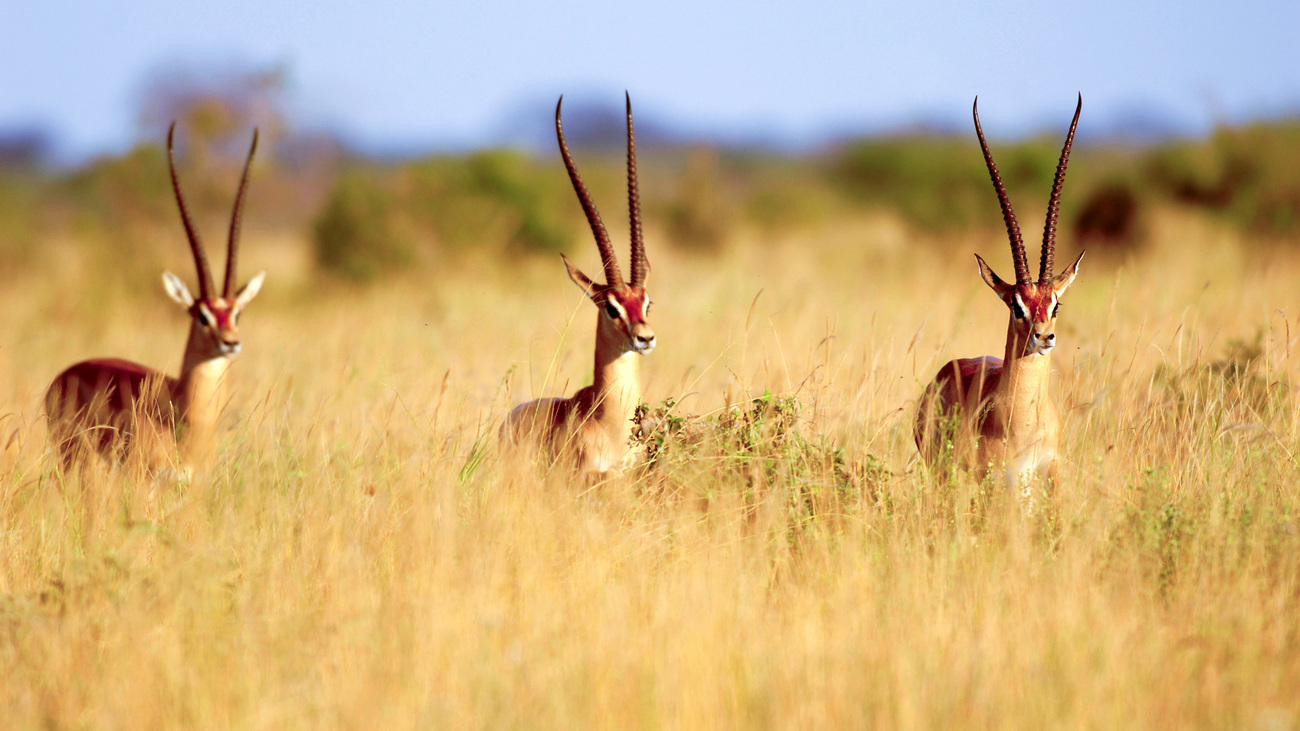Grant’s gazelles
What is Grant’s gazelle?
Grant’s gazelle is a medium-sized antelope species native to East Africa. They have tan or light brown coats, white bellies, long, lyre-shaped horns, and a distinctive white rump with dark stripes running along their sides. Their physical build—with long legs and light frames—makes them swift and agile runners, helping them escape predators.
As herbivores, Grant’s gazelles primarily sustain themselves on grasses, though they occasionally also eat leaves and shrubs. Their feeding habits contribute significantly to regulating vegetation and play a crucial role in shaping the structure of the ecosystems they inhabit.
These gazelles are native to East Africa and gravitate toward open grasslands and savannahs. Over millennia, they have adapted to live in semi-arid regions with scarce water sources. They typically avoid areas of dense vegetation, where visibility can be low and predators can more easily sneak up on them. As they’re targeted by apex predators like cheetahs and hyenas, they have also developed defence mechanisms—like their unique ‘stotting’ behaviour where they leap into the air with all four feet off the ground—to signal to predators that they’re fit and agile and not a good target.
In their social structure, Grant’s gazelles are known to form groups or herds led by a dominant male. These males breed with most females in the herd throughout the year, with the female signalling that she is ready to mate by lifting her tail and holding it out horizontally. Females leave the herd seven months later to give birth in a secluded spot, and the new mothers often join together for protection. Fawns are nursed three to four times a day and are unable to move for the first two weeks of their lives. When the fawn can stand, the mother and young return to their herd.
Grant’s gazelles are integral to the intricate web of predator-prey dynamics in their ecosystems. As prey animals, predators rely on them as a food source, so they help maintain the delicate balance of the food chain. As herbivores, they also help prevent overgrowth of plant species. Understanding and preserving their role in these ecosystems is essential for the conservation and sustainability of East African landscapes.
What is Grant’s gazelle’s scientific name?
The scientific name for Grant’s gazelle is Nanger granti. However, there are three subspecies of Grant’s gazelles, each of which has a unique scientific name:
- Grant’s gazelle (Nanger granti granti)
- Bright’s gazelle (Nanger granti notata)
- Peter’s gazelle (Nanger granti petersii)
Are Grant’s gazelles endangered?
While the IUCN classes Grant’s gazelles as least concern, they do have a declining population.
These animals face a number of threats which contribute to their dwindling numbers. They are hunted by humans for their meat and are being edged out of their natural habitat by human expansion. Grant’s gazelles are also threatened by the extreme drought sweeping the African continent.
Where do Grant’s gazelles live?
Grant’s gazelles are endemic to Africa, specifically East Africa. They can be found from southern Sudan and Ethiopia to central Tanzania and from the coast of Kenya and Somalia to Lake Victoria.
Grant’s gazelles are well adapted to semi-arid regions with sparse vegetation where they can obtain sufficient food and water. They are a migratory species, travelling across the land to find habitats which best suit their needs—they are particularly fond of open grass plains. Though they also hang out in savannah areas, they tend to avoid bushy grassland, where the thick vegetation may impede their speed when trying to escape predators. Though they are an adaptable species, just like any other wild animal, their presence is closely tied to the availability of food, water, and suitable cover.
Threats
While Grant’s gazelles are widespread, only around 25% of the population is considered stable or to be increasing.
Grant’s gazelles face several threats that impact their populations, including hunting, drought, and human expansion. Each poses distinct challenges to the survival of these gazelles, affecting their habitat, food availability, and overall well-being.

Human expansion
Human expansion, including agriculture, infrastructure development, and urbanisation, is a leading cause of habitat loss for Grant’s gazelles. As natural landscapes are converted into human settlements or agricultural areas, the gazelles lose critical grazing grounds.
This leads to habitat fragmentation, which isolates populations, making it challenging for gazelles to migrate, find mates, and access resources. In turn, this can lead to genetic isolation and make it much harder for the species as a whole to survive.
Hunting
Grant’s gazelles are often hunted for their meat, hides, and horns. Despite legal protections in place in many regions, poaching remains a significant threat. With their tall, curved horns and their tendency to live in areas with sparse vegetation, they are easy for hunters to follow and kill.
Trophy hunting also endangers these gazelles in some areas, as hunters target them for sport. Although some regions have regulations in place, poorly managed hunting can lead to population declines.
Droughts
Grant’s gazelles rely on natural water sources in their habitat for survival, but in recent years, Kenya has been experiencing its worst drought in four decades, leading to the deaths of thousands of wild animals.
Prolonged droughts can lead to water scarcity, impacting Grant’s gazelles’ ability to access drinking water and also affecting the growth of the plants which make up their diet.
FAQs
What do Grant’s gazelles look like?
This species does somewhat resemble Thomson’s gazelles, though Grant’s gazelles are slightly larger and have distinctive white patches on their rumps which extend up their backs. Some varieties of Grant’s gazelles also have a broad, dark stripe running along each side, contrasting with the light tan colour of their bodies. Their tails are short and tufted at the end, and they have big ears that help to regulate their body temperature in hot African weather conditions. Both males and females have long curved horns.
Females also have white hair on their udders and black skin surrounding the teats, which scientists assume is to help the young gazelles find the source of milk.

How big are Grant’s gazelles?
Male Grant’s gazelles are larger than females and, on average, weigh 45 to 65 kilograms (100 to 145 pounds). When measured from nose to tail, they are 140 to 166 centimetres (4.5 to 5.5 feet) long.
Do female Grant’s gazelles have horns?
Both male and female Grant’s gazelles have horns, though the males’ horns are much longer and stronger than the females’.
The horns are long, lyre-shaped, and ringed, and they can reach impressive lengths of 50 to 80 centimetres (20 to 31 inches) in males. They are dark brown and slender, with a thick base. Females’ horns are smaller and thinner, while large older males have the thickest horns.
What do Grant’s gazelles eat?
Grant’s gazelles are more browsers than grazers, meaning they primarily eat woody vegetation like leaves and stems rather than green, herbaceous plants. However, they have been known to also feed on foliage, short grasses, and shoots.
Is a Grant’s gazelle a herbivore?
Yes, Grant’s gazelles eat only plants. Unlike other African mammals, they are not dependent on water sources, so they tend to migrate in the opposite direction to other species. Of course, they still need water, but they have adapted to obtain the moisture they need from the food they eat. Thanks to their large salivary glands, they can secrete fluid to help cope with their relatively dry diet. This means Grant’s gazelles can avoid competition with other species and thrive by eating vegetation found in semi-arid habitats.
What is the difference between Thomson’s gazelle and Grant’s gazelle?
Thomson’s gazelle and Grant’s gazelle are both medium-sized antelopes found in East Africa, but while they may seem similar at first glance, they have distinct characteristics.
Thomson’s gazelles are generally smaller than Grant’s gazelles and also have a slightly redder coat than Grant’s tan fur. The main difference is the white marking on their tails. On Grant’s gazelles, the patch always extends above the tail onto the rump.

What are the predators of Grant’s gazelle?
Grant’s gazelles face predation from apex predators such as lions and leopards, though they are most commonly preyed on by cheetahs and wild dogs.
To avoid becoming prey, these gazelles rely on their incredible speed and agility to outrun predators. They also tend to avoid areas with heavy vegetation so that they can’t be snuck up on. Additionally, their ‘stotting’ behaviour—where gazelles leap into the air with all four feet off the ground—is thought to signal their health and agility to potential predators, possibly deterring attacks.
How can you help?
Grant’s gazelles have a declining population, and the IUCN has stated that it’s only a matter of time before the species will be re-classed as near threatened. IFAW is dedicated to helping vulnerable animals around the world and supporting nature-based solutions to climate change.
